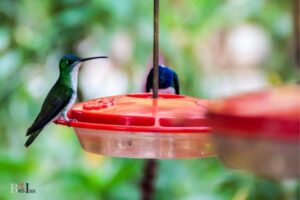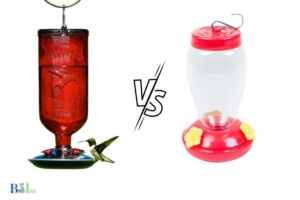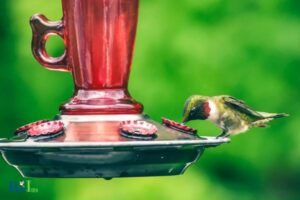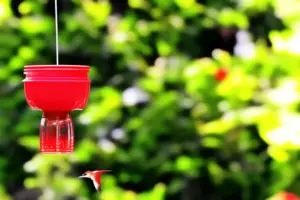What Do Ruby Throated Hummingbirds Eat
Ruby-throated Hummingbirds mainly feed on nectar from flowers, tree sap and insects.
They use their long, slender bills to extract nectar from flowers, and their long, sticky tongues to lap up the sugary liquid.
However, they also rely on small insects as a major source of protein, which they catch with their bills during flight.
Ruby-throated Hummingbirds are tiny birds adapted to taking advantage of a variety of nectar and insect sources for sustenance.
Instead of foraging on the ground, these birds must take to flight in order to find the food they need to survive, relying on their specialized bills and tongues to gain access to a wide range of sources.

What is a Ruby Throated Hummingbird?
A Ruby-throated Hummingbird (Archilochus colibris) is a species of hummingbird found in North and Central America. They nest in deciduous forests, urban and suburban gardens, and other habitats.
These lightweight birds are well adapted for their small size, with a short and pointed bill, long wings and tail, and very short legs. As one of the smaller and more vibrant birds, the Ruby-throated Hummingbird is loved by many for its beauty and grace.
They feed on insects, nectar, and whatever else they can find in their natural habitat. They breed in the late spring and early summer, producing a single brood per year.
The female builds the nest alone, incubates the eggs and rears the young. The males are usually seen solo, like most other Hummingbird species. Some of their characteristics include:

What Does a Ruby Throated Hummingbird’s Diet Consist Of?
The primary diet of a Ruby-throated Hummingbird consists of nectar, pollen, and insects. Nectar comprises the majority of the diet, and can be found in flowers or purchased as a sugar-water solution.
Pollen is obtained mainly from flowers and is a protein-rich supplement. Insects, including spiders, tiny moths, and fruit flies, provide valuable sources of protein, lipids and caloric energy.
In addition to these main food sources, Ruby-throated Hummingbirds also enjoy a variety of fruits, including grapes, bananas, and oranges.
The following are five primary components of a Ruby-throated Hummingbird’s diet:

Where Do Ruby Throated Hummingbirds Find Their Food?
Ruby-throated Hummingbirds find their food primarily in flowering plants. They use their long, thin beaks to reach the nectar they feed on, and they also use their beaks to catch small insects that provide extra nutrition.
They also feed on sap leaking from trees, and even small spiders. In addition, they may visit bird feeders to supplement their diets.
What are the Nutritional Benefits of a Ruby Throated Hummingbird’s Diet?
The ruby-throated hummingbird’s diet typically consists of nectar from flowers, insects, sap from trees and spider webs. Nutritionally, these provide carbohydrates for energy, protein for muscle growth, and minerals for general health.
The nectar consumed by hummingbirds consists of sugar, phosphorus, potassium, iron and calcium. Insects contain protein, lipids, carbohydrates and vitamins, providing essential nutrition for the hummingbird.
Eating tree sap and spider webs provides more protein and fats. By consuming a variety of foods, hummingbirds are able to get the full range of nutrients needed for a healthy diet.
The nutritional benefits of a ruby-throated hummingbird’s diet include:

How Does a Ruby Throated Hummingbird Eat?
The Ruby Throated Hummingbird feeds on nectar from flowers, caught in mid-air, sap from trees, and a variety of small insects. It has a long, extendable tongue that allows it to reach inside flowers and capture nectar. It also catches flying insects, such as gnats, mosquitos, and midges, as it flutters around in mid-air. The birds also occasionally visit sugar-water feeders found in backyards. The Ruby Throated Hummingbird also feeds on small fruits, such as crabapples and cherries.

Key Points:
What Are the Challenges of Finding Food for a Ruby Throated Hummingbird?
It can be challenging for a ruby-throated hummingbird to find food due to their small size and the limited number of food sources available. Some of the challenges they face include:
In order to help hummingbirds thrive, it is important to provide them with convenient sources of food and create specific hummingbird-friendly areas in your garden.
Planting flowers that produce lots of nectar, such as roses, lilies, and hibiscus, can increase the number of hummingbirds in your area.

Additionally, setting up hummingbird feeders with sugar water can provide them with a reliable food source year-round.
Are There Any Natural Predators of Ruby Throated Hummingbirds?
Yes, there are various natural predators of the Ruby Throated Hummingbird. These include the following:
Hummingbirds are relatively safe from predation when in mid-air. However, whilst resting or feeding on flowers, leaves, or bird feeders, they are much more vulnerable to predation.

It is important to reduce the threat from predatory animals by providing ample shelter and keeping cats and pet birds at a safe distance.
FAQ
What does the Ruby Throated Hummingbird typically eat?
What type of nectar do they prefer?
How often do Ruby Throated Hummingbirds feed?
How do they get their water?
Conclusion
Ruby-throated Hummingbirds are incredible creatures that are able to feed on nectar, tree sap and insects using their specialized bills and tongues. They must rely on flight to find the food they need in order to survive, and have adapted well to take advantage of sources they can find in their environment.






